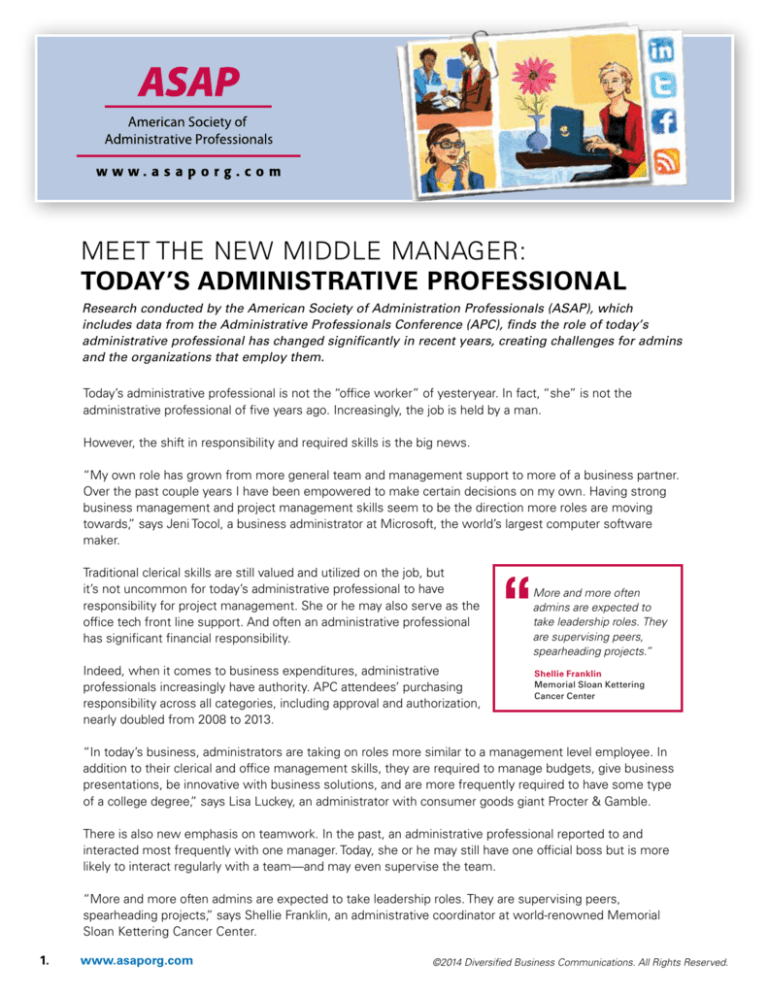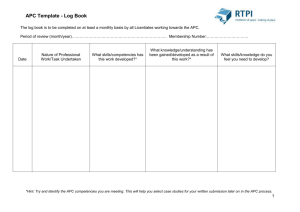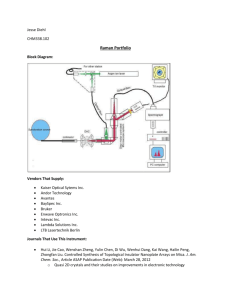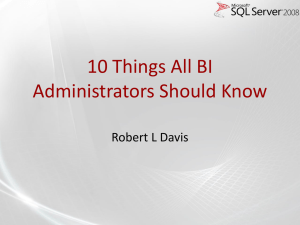
MEET THE
NEW MIDDLE MANAGER:
TODAY’S ADMINISTRATIVE PROFESSIONAL
Research conducted by the American Society of Administration Professionals (ASAP), which
includes data from the Administrative Professionals Conference (APC), finds the role of today’s
administrative professional has changed significantly in recent years, creating challenges for admins
and the organizations that employ them.
Today’s administrative professional is not the “office worker” of yesteryear. In fact, “she” is not the
administrative professional of five years ago. Increasingly, the job is held by a man.
However, the shift in responsibility and required skills is the big news.
“My own role has grown from more general team and management support to more of a business partner.
Over the past couple years I have been empowered to make certain decisions on my own. Having strong
business management and project management skills seem to be the direction more roles are moving
towards,” says Jeni Tocol, a business administrator at Microsoft, the world’s largest computer software
maker.
Traditional clerical skills are still valued and utilized on the job, but
it’s not uncommon for today’s administrative professional to have
responsibility for project management. She or he may also serve as the
office tech front line support. And often an administrative professional
has significant financial responsibility.
Indeed, when it comes to business expenditures, administrative
professionals increasingly have authority. APC attendees’ purchasing
responsibility across all categories, including approval and authorization,
nearly doubled from 2008 to 2013.
More and more often
admins are expected to
take leadership roles. They
are supervising peers,
spearheading projects.”
Shellie Franklin
Memorial Sloan Kettering
Cancer Center
“In today’s business, administrators are taking on roles more similar to a management level employee. In
addition to their clerical and office management skills, they are required to manage budgets, give business
presentations, be innovative with business solutions, and are more frequently required to have some type
of a college degree,” says Lisa Luckey, an administrator with consumer goods giant Procter & Gamble.
There is also new emphasis on teamwork. In the past, an administrative professional reported to and
interacted most frequently with one manager. Today, she or he may still have one official boss but is more
likely to interact regularly with a team—and may even supervise the team.
“More and more often admins are expected to take leadership roles. They are supervising peers,
spearheading projects,” says Shellie Franklin, an administrative coordinator at world-renowned Memorial
Sloan Kettering Cancer Center.
1.
www.asaporg.com
©2014 Diversified Business Communications. All Rights Reserved.
The shift from assistant to a managerial role has happened relatively quickly. In 2008, only 7 percent of
APC attendees held non-traditional admin job titles; most were assistants. Five years later, in 2013, more
than 22 percent of APC attendees held titles like manager and project coordinator.
Make no mistake: These are not symbolic titles.
“The admin professional is being utilized to manage projects, manage direct reports, and even make
decisions on behalf of their executives on a more routine basis,” says Jen Bogle, an administrative
assistant at The Kroger Company, one of the world’s largest grocery retailers.
And with or without a title that accurately reflects the job function,
the role has changed.
“We are no longer the 9-5, type a memo and answer the phone
secretaries we once were known for. We are now the business
partner to the executive and teams we support in which most cases
is assuming the role of project manager and chief of staff,” says
Christopher Whibley, an executive assistant at Elsevier Inc.,
a leading provider of health and science information.
In 2008, only 7 percent of APC
attendees held non-traditional
admin job titles; in 2013,
more than 22 percent held
titles like manager and project
coordinator.
Source: ASAP/APC
But why the shift, and why now?
DRIVERS OF CHANGE
The role of the administrative professional has been impacted by three drivers of change: the recession
and its aftermath; evolving technology; and an improving economy.
The Recession and its Aftermath
It’s worth recalling how the fallout from the Great Recession took its toll on organizations. The economy
lost 8.4 million jobs in 2008 and 2009,1 including many middle manager positions.
Yet, even as the economy began to show signs of improvement in 2010, manager jobs did not rebound.
In fact, for 2010, “managers” was the occupational category with the biggest job losses, according to
the National Employment Law Project, a non-profit research organization, which tracked job gains postrecession.2
Other research from the National Employment Law Project suggests
managerial job growth has remained slow. The majority of new jobs
created through 2012 were in lower-wage occupations,3 in other
words, not managers.
There has been a lot of talk about organizations making do with
less staff, which has become the new reality. Redistribution of work
hasn’t only affected remaining managers. In many instances, flatter
2.
www.asaporg.com
For 2010, “managers” was the
occupational category with the
biggest job losses.
Source: Employment Law Project
©2014 Diversified Business Communications. All Rights Reserved.
organizations have meant administrative professionals have taken on greater responsibility.
This change is also reflected in the job candidates organizations are seeking to fill open admin positions.
“The requirements for administrative jobs have expanded in recent years and this shows there’s a trend
towards employers seeking versatile administrative professionals who can ‘wear many hats’ within an
organization,” says Robert Hosking, executive director of OfficeTeam, a Robert Half company and leading
staffing firm specializing in placing office and administrative support professionals.
Evolving Technology
At the same time, increased use of technology, including mobile technology, and the proliferation of social
media, has placed new demands on organizations.
Constant connectivity has created a need for more frequent communication. It has also accelerated
decision-making, resulting in a more dynamic and faster-paced work environment.
Social media has added new dimensions to the mix, making it almost a mandate for organizations to
maintain communication on multiple channels with the world at large.
Navigating this changing technological landscape requires time,
effort, and know-how. Not surprising, organizations are turning to
administrative professionals for assistance—and hiring new admins
with attention to these skills.
“A strong understanding of Microsoft Office applications remains
in demand, but businesses are also starting to seek administrative
professionals who are familiar with social media,” says Hosking.
“In some cases, support staff may be involved in monitoring and
responding to customer feedback on sites such as Facebook, Twitter,
LinkedIn, and Google+.”
A strong understanding
of Microsoft Office
applications remains in
demand, but businesses
are also starting to seek
administrative professionals
who are familiar with social
media.”
Robert Hosking
OfficeTeam
Improving Economy
Social and mobile technologies have contributed to a faster-paced work environment, but so has an
improving economy.
Amid fierce competition, organizations are positioning themselves, often with limited managers, to take
advantage of growth opportunities.
“As the economy improves and workloads rise, companies need staff who can thrive during change and who
are adaptable enough to jump in to help even if it’s outside their traditional job description,” Hosking says.
That staff includes multi-skilled administrative professionals, and there appear to be no shortage of job
opportunities for these individuals in the foreseeable future.
3.
www.asaporg.com
©2014 Diversified Business Communications. All Rights Reserved.
BY THE NUMBERS
Approximately 7,894,100 people were employed as administrative professionals across various job
categories in 2012, the most recent year for which data is available from the U.S. Bureau of Labor
Statistics (BLS). A net increase of 12 percent in administrative professional jobs across these categories
is projected for the 2012-2022 timeframe.4
Perhaps not surprising, the largest increase, from a percentage standpoint, 39 percent, is projected in the
medical field, as changes in health care place greater demands on medical practices and other providers
of health care services.
As might be expected, salaries vary greatly from position to position, depending on employer size and
geographic location.
Even so, the 2014 Salary Guide from OfficeTeam5 suggests an overall positive trend with regard to pay.
OfficeTeam’s year-over-year salary projections 2014 vs. 2013 for 62 administrative professional positions
average slightly above the 2.9 to 3 percent projected for jobs across all industries in surveys conducted by
Towers Watson,6 Buck Consultants,7 and Hay Group.8 On average, administrative professionals can expect
to see a 3.3 percent salary increase in 2014.
As far as salary increases, administrative professionals are faring slightly better than coworkers in other
jobs, which is good news, given that in recent years admins have assumed greater responsibility.
But the question remains: Is today’s administrative professional prepared for today’s admin job?
NEED FOR SKILLS DEVELOPMENT
One of the strengths of today’s administrative professional is industry knowledge; nearly 92 percent of APC
2013 attendees have been in their current industry for five years or more.
However, 38 percent of admins have been in their current role for three years or less, suggesting a need for
skills development.
Be that as it may, a recent OfficeTeam survey of HR managers in North America finds that less than half of
organizations, 46 percent, currently offer or plan to offer subsidized training for administrative professionals
in the next 12 months.9
In addition, ASAP research finds that although administrative professionals may have organizational support,
seeking training often falls to them. APC attendance was self-initiated by 37 percent of administrative
professionals; only 12 percent of admins attended the conference at the suggestion of their manager, HR or
training department.
Meanwhile, when it comes to technical expertise, there’s no disputing it’s a job requirement—and that a
training gap exists.
4.
www.asaporg.com
©2014 Diversified Business Communications. All Rights Reserved.
A recent ASAP poll asked administrative professionals what percentage
of their workday is spent using Microsoft Office applications. An
overwhelming majority of admins, 85 percent, spends between 61
and 100 percent of their workday using the software.
Nevertheless, when ASAP asked admins to rate their level of expertise
using Microsoft Office applications, only 13 percent say they view
themselves as expert—despite the fact that many admins are
considered the office tech guru.
Much advertising is done
through social media, yet we
don’t really know what’s out
there, let alone how to work
with it on a day-to-day basis.”
Sarah Meineke
Procter & Gamble
An APC survey finds administrative professionals use a wide range of technologies and platforms, including
collaboration and communication tools such as FaceTime, Skype, and SharePoint, among others.
“Technology has become such a focus of our world; it is critical to keep up,” says Sarah Meineke, an
administrative assistant at Procter & Gamble, who acknowledges that she’s among those seeking training
on “how to be the ‘go-to technology guru’ of your office.”
There appears to be a widespread need for such training. Another ASAP poll asked administrative
professionals about their primary method for learning a new technology, whether software or hardware.
A majority, 58 percent, says they teach themselves, while another 10 percent say they search online.
Social media expertise is also lacking.
“Much advertising is done through social media, yet we don’t really know what’s out there, let alone how to
work with it on a day-to-day basis,” says Meineke.
And she is not alone. A survey of APC attendees finds slow adoption of social media among administrative
professionals: While 48 percent are on Facebook, only 28 percent are on LinkedIn, only 11 percent are on
Twitter, and 15 percent don’t use social media at all.
46%
85
%
5.
An overwhelming majority of
admins, 85 percent, spends
between 61 and 100 percent of
their workday using Microsoft
Office applications.
Less than half of organizations,
46 percent, currently offer or
plan to offer subsidized training
for administrative professionals
in the next 12 months.
Source: ASAP
Source: OfficeTeam
www.asaporg.com
13
%
Only 13 percent of admins view
themselves as experts in using
Microsoft Office applications
Source: ASAP
©2014 Diversified Business Communications. All Rights Reserved.
PROVIDING TRAINING
ASAP research strongly suggests that today’s administrative professional, who has assumed middlemanager responsibilities, is striving to rise to the challenges of the position.
However, in order to more effectively contribute to the organization—and further its bottom line—the
bottom line is she and he could benefit from additional opportunities for skills development.
Attending conferences geared toward administrative professionals, like the Administrative Professionals
Conference (APC) and other events which feature a broad spectrum of training sessions on a variety of
topics, is one way for an admin to expand her or his skill set. Indeed, a survey of APC attendees finds 94
percent of admins attended the 2013 conference for training.
Joining a professional association, like the American Society of Administrative Professionals (ASAP) or other
organization, also offers opportunities for skills development. ASAP, for example, provides its members with
an array of resources, including articles, webinars, online training, a mentoring program, and more.
For employers concerned about the cost of training, it’s important to note that many training opportunities
for administrative professionals are available at low or no cost. ASAP membership, for example, is free.
(Endnotes)
1
Economic Policy Institute.: http://stateofworkingamerica.org/great-recession/
National Employment Law Project: http://www.nelp.org/page/-/Final%20occupations%20report%207-25-11.
pdf?nocdn=1
2
Plumer, Brad. “How the recession turned middle-class jobs into low-wage jobs.” The Washington Post, Feb.
28, 2013: http://www.washingtonpost.com/blogs/wonkblog/wp/2013/02/28/how-the-recession-turned-middleclass-jobs-into-low-wage-jobs/; National Employment Law Project: http://www.nelp.org/page/-/Job_Creation/
LowWageRecovery2012.pdf?nocdn=1
3
U.S. Bureau of Labor Statistics: http://www.bls.gov/ooh/office-and-administrative-support/secretaries-andadministrative-assistants.htm#tab-6
4
OfficeTeam 2014 Salary Guide: http://www.roberthalf.com/officeteam/administrative-salary-center
5
Towers Watson. “Most U.S. Companies Planning Moderate Pay Raises for 2014, Towers Watson Survey Finds”:
http://www.towerswatson.com/en-US/Press/2013/09/most-us-companies-planning-moderate-pay-raises-for-2014
6
Buck Consultants. Compensation Planning for 2014 Survey: https://www.bucksurveys.com/bucksurveys/
Surveys/CompensationPlanning/tabid/70/Default.aspx
7
Hay Group. “Forecasted US base salary increases remain stable, while employees see net gains, new Hay
Group research finds”: http://www.haygroup.com/ww/press/details.aspx?id=37634
8
OfficeTeam survey of HR managers, OfficeTeam 2014 Salary Guide, p. 4: http://www.roberthalf.com/officeteam/
administrative-salary-center
9
6.
www.asaporg.com
©2014 Diversified Business Communications. All Rights Reserved.
About the American Society of Administrative Professionals
The American Society of Administrative Professionals (www.asaporg.com) was established in 2005 to
provide year-round, on-line, professional development, training and resources to address the changing roles
and demanding responsibilities of Administrative Professionals and Executive Assistants.
Membership to ASAP is free and includes access to articles and columns focusing on business skills
and career development, the popular monthly FastTrack newsletter, and “Learn It in a Minute” videos.
Members also have access to hundreds of on-demand training courses and webinars. Additionally, ASAP
members have the opportunity to participate in a prestigious certificate program, the Professionals
Administrative Certificate of Excellence (PACE).
There are currently more than 45,000+ ASAP members in North America and around the world.
About the Administrative Professionals Conference
The premier annual training event for administrative professionals and executive assistants in the US, the
Administrative Professionals Conference (APC) provides essential training to strengthen skills, improve
productivity, and increase value to their bosses and organizations. Now in its 22nd year, the APC has
helped to advance the careers of thousands of admins from thousands of public, private, and government
organizations by equipping them with the knowledge and expertise to adapt to new technologies, increased
workloads, evolving roles, and expanding responsibilities.
Categories of training at the APC include: Office & Digital Technologies, Project & Task Management,
Management Skills, Leadership, Interpersonal Communications, and Career Development.
About the Executive Assistants’ Summit
The Executive Assistants’ Summit (EA Summit) is an exclusive program developed to meet the unique
training needs of Executive Assistants who work directly with senior executives, including the CEO, COO,
CIO, CFO, President, Managing Director, EVPs, and SVPs. It takes place concurrently with the annual
Administrative Professionals Conference.
The American Society of Administrative Professionals (ASAP) has produced the Administrative Professionals Conference
since 2005 and the Executive Assistants’ Summit since 2013. The association and events are managed by global media company
Diversified Communications.









